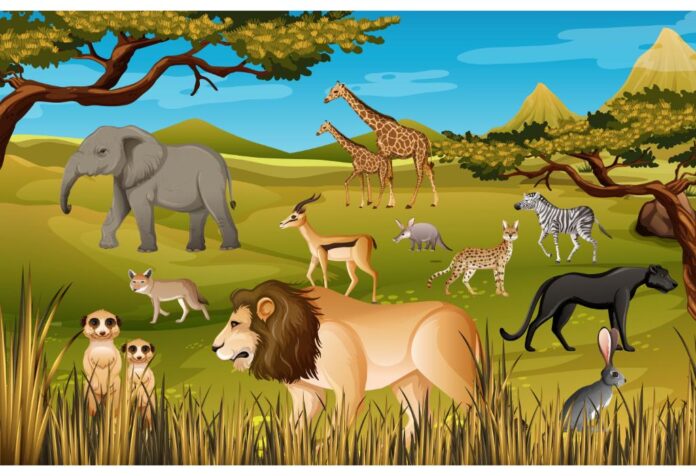In This Article
The world is home to a vast array of wild animals, each species uniquely adapted to its environment. From the dense forests to the wide savannas and the deep oceans, wild animals play a crucial role in maintaining the delicate balance of ecosystems. Some are fierce predators, while others are gentle herbivores, but all contribute to the richness and diversity of life on Earth. Whether admired for their strength, beauty, or agility, wild animals continue to fascinate and inspire us with their incredible survival skills and behaviors.
Wild Animal Names – List of 100 Wild Animals in English
| Tiger | Lion | Elephant | Leopard |
| Panther | Cheetah | Wolf | Jaguar |
| Hyena | Giraffe | Deer | Zebra |
| Gorilla | Monkey | Chimpanzee | Bear |
| Wild Boar | Hippopotamus | Kangaroo | Rhinoceros |
| Crocodile | Panda | Squirrel | Mongoose |
| Porcupine | Koala Bear | Wombat | Meerkat |
| Otter | Hedgehog | Possum | Chipmunk |
| Squirrel | Raccoon | Jackal | Hare |
| Mole | Rabbit | Alligator | Monitor Lizard |
| Oryx | Elk | Badger | Dinosaur |
| Pangolin | Mole | Okapi | Camel |
| Wild cat | Coyote | Bison | African Elephant |
| Aardvark | Antelope | Alpine Goat | Komodo Dragon |
| Bearded Dragon | Royal Bengal Tiger | Flying Squirrel | Emu |
| Eagle | Eel | Asiatic Lion | Armadillo |
| Beaver | Emperor Penguin | Baboon | Bat |
| Chameleon | Bull | Giant Panda | Chihuahua |
| Orangutan | Chinchillas | Hawk | Iguana |
| Ibis | Ibex | King Cobra | Jellyfish |
| Goose | Walrus | Seal | Skink |
| Markhor | Falcon | Bull Shark | Arctic Wolf |
| Owl | Bulbul | Bobcat | Guinea Pig |
| Yak | Reindeer | Moose | Puma |
| Okapi | Marten | Squirrel Monkey | Caracal |
Explore More about the Wild Animals
Here’s a list of wild animal names along with descriptions and common facts about each:
1. Lion
Description: The lion, known as the “king of the jungle,” is a large carnivorous feline that lives in Africa and parts of Asia. Males are distinguished by their majestic manes, while females are smaller and lack manes.
Common Facts:
- Lions live in groups called prides, consisting of females, their offspring, and a few males.
- They are apex predators, often hunting large prey like zebras and buffaloes.
- Male lions roar to establish territory and communicate over long distances.
2. Elephant
Description: Elephants are the largest land animals, recognized by their long trunks, large ears, and tusks. There are two main species: the African elephant and the Asian elephant.
Common Facts:
- Elephants are highly intelligent and have strong memories.
- They use their trunks for various tasks, such as drinking water and grabbing objects.
- Elephants are social animals and live in herds led by a matriarch (female leader).
3. Tiger
Description: The tiger is the largest species of the cat family and is native to Asia. Its coat is orange with black stripes, making it highly recognizable.
Common Facts:
- Tigers are solitary animals and prefer to live and hunt alone.
- They are excellent swimmers and often cool off in rivers and lakes.
- The Bengal tiger is the most numerous tiger subspecies.
4. Wolf
Description: Wolves are highly social animals that live in packs. They have thick fur, long legs, and strong jaws. Gray wolves are the most common species, found in forests, tundras, and plains across the Northern Hemisphere.
Common Facts:
- Wolves communicate using howls, which help coordinate pack activities.
- They have a strong hierarchy within their packs, led by an alpha male and female.
- Wolves are essential to maintaining the ecological balance by controlling prey populations.
5. Leopard
Description: Leopards are large wild cats known for their spotted coats, adaptability, and stealth. They are found in sub-Saharan Africa and parts of Asia.
Common Facts:
- Leopards are strong climbers and often drag their prey up into trees to protect it from scavengers.
- They are solitary animals, usually only coming together to mate.
- Their spots, called rosettes, help them blend into their surroundings for hunting.
6. Giraffe
Description: The giraffe is the tallest land animal, known for its long neck and legs. They live in African savannas and are herbivores that feed primarily on tree leaves.
Common Facts:
- A giraffe’s long neck allows it to reach leaves that are out of reach for other herbivores.
- Despite their height, giraffes only have seven neck vertebrae, the same as humans.
- They can run at speeds up to 35 miles per hour (56 km/h).
7. Zebra
Description: Zebras are equine animals, known for their distinctive black-and-white striped coats. They live in grasslands and savannas of Africa.
Common Facts:
- Each zebra’s stripe pattern is unique, much like human fingerprints.
- Zebras live in herds for protection and rely on their stripes to confuse predators.
- They primarily graze on grasses and have strong teeth to chew tough vegetation.
8. Kangaroo
Description: Kangaroos are marsupials native to Australia, recognized by their strong hind legs, large feet, and long tail. They are known for their unique hopping movement.
Common Facts:
- Female kangaroos carry their young, called joeys, in a pouch.
- Kangaroos can cover large distances in short bursts by hopping, reaching speeds of up to 35 miles per hour (56 km/h).
- They are herbivores, feeding on grasses and shrubs.
9. Grizzly Bear
Description: The grizzly bear is a large subspecies of brown bear found in North America. They have a distinct hump on their shoulders, powerful limbs, and thick fur.
Common Facts:
- Grizzlies are omnivores, eating both plants and animals, and are known for their ability to catch fish, especially salmon.
- They hibernate during winter months, surviving off fat stored from the warmer months.
- Grizzly bears are solitary, except during mating season or when females are with their cubs.
10. Cheetah
Description: Cheetahs are the fastest land animals, capable of reaching speeds of up to 60-70 miles per hour (97-113 km/h) in short bursts. They are found in Africa and parts of Iran.
Common Facts:
- Cheetahs have slender bodies, long legs, and distinctive black “tear marks” that run from the eyes down to the mouth.
- Unlike other big cats, cheetahs cannot roar, but they make a variety of sounds, including purring and chirping.
- They rely on speed rather than stealth to catch prey, primarily small to medium-sized antelopes.
These wild animals showcase a diverse range of habitats, behaviors, and adaptations that help them survive in the wild.
Wild animals are an essential part of our natural world, representing the power, beauty, and complexity of life in the wild. Each species, no matter how big or small, has a role to play in maintaining the balance of ecosystems. By learning about and appreciating these animals, we can deepen our understanding of the natural world and the importance of conservation efforts to protect these incredible creatures. From the lion’s roar to the cheetah’s speed, wild animals remind us of nature’s wonders and the need to preserve their habitats for future generations.













